- News
- Reviews
- Bikes
- Components
- Bar tape & grips
- Bottom brackets
- Brake & gear cables
- Brake & STI levers
- Brake pads & spares
- Brakes
- Cassettes & freewheels
- Chains
- Chainsets & chainrings
- Derailleurs - front
- Derailleurs - rear
- Forks
- Gear levers & shifters
- Groupsets
- Handlebars & extensions
- Headsets
- Hubs
- Inner tubes
- Pedals
- Quick releases & skewers
- Saddles
- Seatposts
- Stems
- Wheels
- Tyres
- Tubeless valves
- Accessories
- Accessories - misc
- Computer mounts
- Bags
- Bar ends
- Bike bags & cases
- Bottle cages
- Bottles
- Cameras
- Car racks
- Child seats
- Computers
- Glasses
- GPS units
- Helmets
- Lights - front
- Lights - rear
- Lights - sets
- Locks
- Mirrors
- Mudguards
- Racks
- Pumps & CO2 inflators
- Puncture kits
- Reflectives
- Smart watches
- Stands and racks
- Trailers
- Clothing
- Health, fitness and nutrition
- Tools and workshop
- Miscellaneous
- Buyers Guides
- Features
- Forum
- Recommends
- Podcast
BUYER'S GUIDE
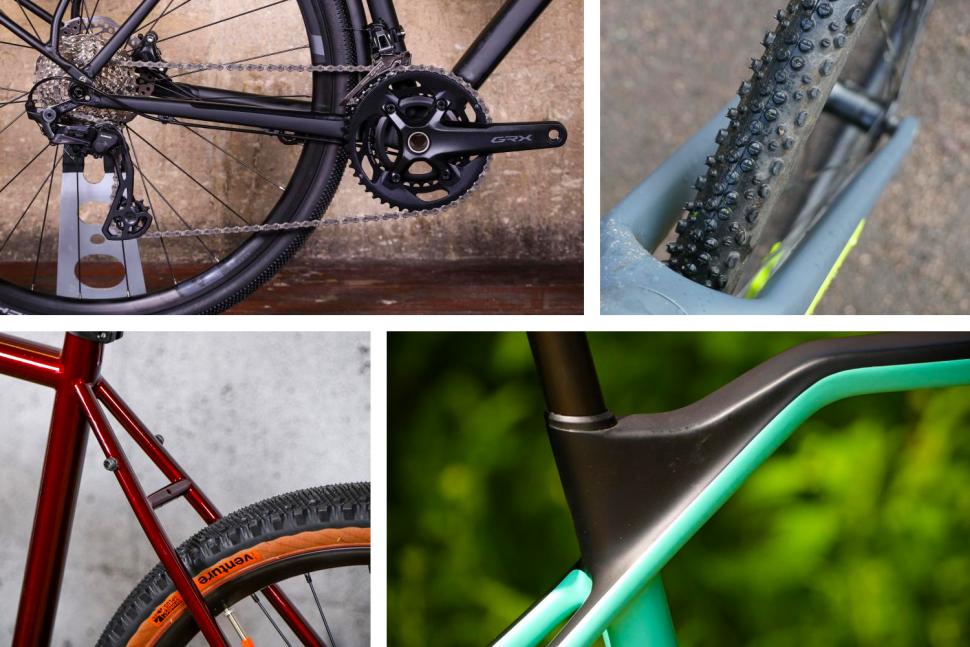 Cyclocross v gravel bikes April 2021
Cyclocross v gravel bikes April 2021Cyclocross v gravel bikes: get to know the clever differences that set them apart
Updated April 25, 2021
What’s the difference between a cyclocross bike and a gravel bike? It’s a question we see asked a lot, as more and more bikes are launched in the gravel bike niche. Let’s try and clear things up.
According to our resident cynic VecchioJo Burt the difference between a cyclocross bike and a gravel bike is “£200”. It’s a bit more complicated than that.
Bike industry labels for bike varieties often confuse people because they usually don’t refer to discrete categories but to points on a spectrum. That means what's labelled a gravel bike can be very similar to a cyclocross bike, especially if you don’t dig deep into the specs.
What are they for?
Form follows function so to kick off, let’s look at what these two bike types are for.
Cyclocross is a bike racing discipline that involves riding a drop-handlebar bike on a short, off-road course, usually in a park or similar. Courses include features like mud, sandpits, barriers and steps or slopes too steep to ride, forcing riders to run, as well as easier sections. An international-grade course has to be between 2.5km and 3.5km long. An elite-level cyclocross race lasts an hour and a lap; other race categories are shorter.
A cyclocross bike is designed specifically for this form of racing, and, as we’ll see, its design serves its purpose of going fast, and being able to be carried when the terrain demands.
>>Read more: Buyer's Guide to cyclocross bikes - how to choose the right one for you
>> Read more: Beginner's guide to cyclo-cross essentials
While there’s an emerging discipline of gravel racing in the USA, most gravel bikes are not purpose-specific racers. Rather they’re designed for long days in the saddle on a mixture of surfaces and terrains and for riding with various types of luggage on multi-day trips.
The key difference between gravel bikes and old-fashioned touring bikes is the baked-in ability to tackle unsurfaced trails, tracks and dirt roads. People took touring bikes off the beaten track in the era before the mountain bike, but fatter tyres make it much easier and more comfortable. A gravel bike combines the multiple hand positions of a road bike with the go-anywhere abilities of a mountain bike.
What design and feature differences come out of these purposes then?
Frames
A cyclocross frame has to be light, because the bike built around it will be carried. That means pared-down aluminium and carbon fibre frames are the norm.
Gravel bike frames are usually a bit heavier, because they need to be stiff enough to carry loads.
A pure cyclocross frame won’t have eyelets for mudguards or racks, because you’ll never need them for racing. But they’re a feature of gravel bikes because you might want to racks to carry luggage, and mudguards to help keep you dry.
A frame’s geometry — the angles and lengths of its various tubes — determines how it handles, and here there are significant differences.
A cyclocross bike will usually have a head tube of around 73° for quick turns, while a gravel bike’s will be a degree or so shallower for steadier handling. And some gravel bikes, like the Fustle Causeway GR1 with it's 69° head tube are heading along the path that's taken mountain bike head tubes down to around 66°.
The riding position is also different, with longer head angles and shorter top tubes on gravel/adventure bikes giving a more upright position.
Out back, a gravel bike will have longer chainstays so there’s heel clearance for panniers. A cyclocross bike typically has 425mm chainstays; on a gravel bike — especially one intended to double as an expedition-touring 'adventure' bike they’re as long as 465mm.
Of course this wouldn’t be the bike industry without glaring exceptions to general rules. Specialized’s carbon fibre Diverge gravel bike has cyclocross-style 425mm chainstays to tuck the back wheel in for more traction on steep climbs.
There are also cyclocross bikes with rack and mudguard eyelets, because bike makers recognise that many riders have picked up ’crossers as fast urban pothole-bashers. Many of these bikes have morphed into gravel bikes or adventure bikes in the last couple of years. The Pinnacle Arkose range from Evans Cycles is a good example. It was originally billed as a cyclocross bike, but now has fatter tyres and Evans calls it an adventure bike.
Read more: Buyer’s guide to gravel and adventure bikes plus 16 of the best
Tyres
The rules set by cycle racing’s governing body, the UCI, say cyclocross tyres have to be no more than 33mm wide. There’s usually room in a cyclocross frame for tyres that are a bit wider than that, and there’s room for mud clearance, but gravel bikes will typically take much bigger tyres. Trek fits 2.0in tyres to its 920 adventure tourer, while Mason's dramatic InSearchOf will take 60mm wide 700C tyres.
However, some, like Cannondale's Topstone bikes, just go a bit fatter with 37mm tyres, while Kona's Rove Ltd has 47mm tyres and 650B wheels, the ‘middle’ size used on mountain bikes. Gravel/adventure bike tyres have definitely got wider in the last couple of years, and that big tread energy has widened the gap between them and cyclocross bikes.
Tubeless-ready wheels are increasingly common on both cyclocross and gravel bikes. Tubeless tyres aren’t susceptible to pinch punctures caused by the tyre bottoming out on the rim — there’s no tube to pinch. They can therefore be run at lower pressures. That means more grip and a comfier ride off road and on.
Gears
Classic cyclocross race gearing combines a 46/36 chainset and a medium-wide cassette like an 11-28. You don’t need the high gears of a road bike because you won’t be zooming downhill at over 40mph, but you still need fairly low gears for climbing the course's more rideable slopes.
Gravel bikes have wider range gearing, but may sacrifice some top end to get lower ratios at the bottom. A 48/31 or 46/30 chainset with an 11-34 cassette is common, and a few bikes widen the range with a 42/28 chainset, or use the ability of the GRX400 derailleur to run an 11-36 cassette. Others go for the simplicity of a single-chainring system with 11, 12 or even 13 rear sprockets.
If you’re an old fart like me, you might be surprised that almost no gravel/adventure bikes have a triple chainset. You could get a bigger range with an extra chainring, but even I have to admit you get a pretty useful range when you combine a 42/28 with an 11-36 cassette.
For workshop tinkerers there are so many reports of 105 and Ultegra GS rear derailleurs and GRX derailleurs for double chainsets shifting fine across 11-40 cassettes that it's now almost a standard recommendation. a 46/30 chainset and 11-40 cassette is a combination you're unlikely ever to see on the start line of an elite cyclocross race.
Brakes
If the UCI hadn’t given the green light in 2010 for cyclocross racers to use disc brakes, the gravel bike category might never have happened — or at least not happened so quickly.
Every gravel bike we can find uses disc brakes. As well as their advantages in stopping power and consistency in the wet, discs have a very big advantage for bikes ridden on lousy surfaces: they’re not affected by rim damage. This is well worth the extra few grams over cantilever brakes.
A tiny handful of cyclocross bikes are still available with cantilever brakes, but cyclocross bikes almost universally use discs too, for much the same reasons.
The big picture
In their purest form cyclocross bikes have a very narrow purpose and that leads to very specific frame design and features. They’re brilliant for cyclocross racing but limited as all-rounders by their lack of provision for mudguards and racks, their relatively narrow gear ranges and inability to take very fat tyres.
For many, the riding position of a pure cyclocross race bike will be too aggressive; fine for an hour and a lap exploring the upper limits of your aerobic range, less ideal for a full day exploring lanes and trails.
Gravel bikes take ideas from cyclocross bikes and throw in fatter tyres from mountain bikes and hybrids, wider gear ranges from touring bikes and all-day riding positions from sportive bikes. The details of the mix vary between manufacturers, but they’re clearly a new, distinctly separate breed.
If you fancy expanding your riding to include dirt roads and trails, but want to get there on the road, the good news is you have plenty of choice. Think about the riding position you prefer, how you’re going to carry luggage — if at all — and the gears you need and take it all into account when you make your choice.
About road.cc Buyer's Guides
The aim of road.cc buyer's guides is to give you the most, authoritative, objective and up-to-date buying advice. We continuously update and republish our guides, checking prices, availability and looking for the best deals.
Our guides include links to websites where you can buy the featured products. Like most sites we make a small amount of money if you buy something after clicking on one of those links. We want you to be happy with what you buy, so we only include a product if we think it's one of the best of its kind.
As far as possible that means recommending equipment that we have actually reviewed, but we also include products that are popular, highly-regarded benchmarks in their categories.
Here's some more information on how road.cc makes money.
You can also find further guides on our sister sites off.road.cc and ebiketips.
road.cc buyer's guides are maintained by the road.cc tech team. Email us with comments, corrections or queries.
John has been writing about bikes and cycling for over 30 years since discovering that people were mug enough to pay him for it rather than expecting him to do an honest day's work.
He was heavily involved in the mountain bike boom of the late 1980s as a racer, team manager and race promoter, and that led to writing for Mountain Biking UK magazine shortly after its inception. He got the gig by phoning up the editor and telling him the magazine was rubbish and he could do better. Rather than telling him to get lost, MBUK editor Tym Manley called John’s bluff and the rest is history.
Since then he has worked on MTB Pro magazine and was editor of Maximum Mountain Bike and Australian Mountain Bike magazines, before switching to the web in 2000 to work for CyclingNews.com. Along with road.cc founder Tony Farrelly, John was on the launch team for BikeRadar.com and subsequently became editor in chief of Future Publishing’s group of cycling magazines and websites, including Cycling Plus, MBUK, What Mountain Bike and Procycling.
John has also written for Cyclist magazine, edited the BikeMagic website and was founding editor of TotalWomensCycling.com before handing over to someone far more representative of the site's main audience.
He joined road.cc in 2013. He lives in Cambridge where the lack of hills is more than made up for by the headwinds.
Latest Comments
- pockstone 13 min 21 sec ago
Remind me...what day is it????
- Natrix 22 min 33 sec ago
Grass snakes (which are green with a yellow band - like the lock) often emit the odour of rotting flesh if disturbed, along with acting dead, in...
- slc 27 min 27 sec ago
That is pretty staggering. The other sixth must have been somewhere else.
- David9694 31 min 5 sec ago
Notwithstanding its collapsing circulation, I still get it quoted to me as a source of news and information in my local Comments section. If I...
- OldRidgeback 41 min 16 sec ago
Using superglue anywhere on the vehicle would be considered as causing damage so that would be an offence. I don't think spreading grease over the...
- hutchdaddy 1 hour 3 min ago
It's clearly a shit car, you won't get your cycle in the back of it and it won't have a CD player.
- essexian 2 hours 21 min ago
Before I had even said this persons home address, my wife said upon hearing the story: "He's from Loggerheads isn't he...."
- Rekrab 11 hours 24 min ago
MORE LANES, MORE LANES!!!!
- Simon E 11 hours 31 min ago
The numbers don't tell anything like the whole story....
- Global Nomad 13 hours 23 min ago
good to see you're testing the farsports wheels - hope to see road.cc continue to expand the range of brands it considers. These or the shallower...
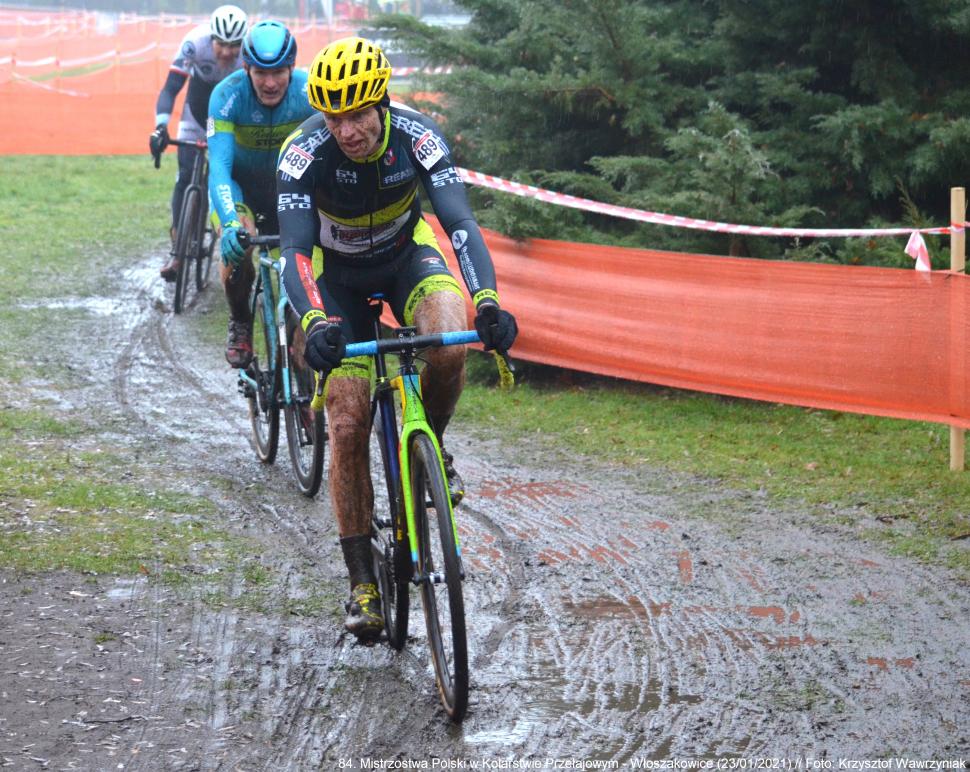
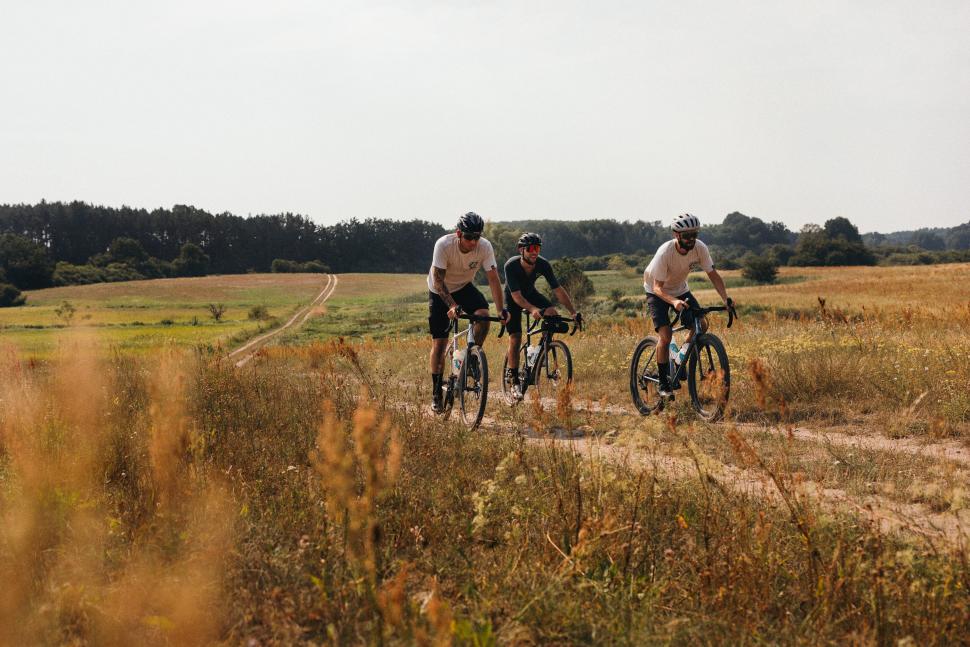

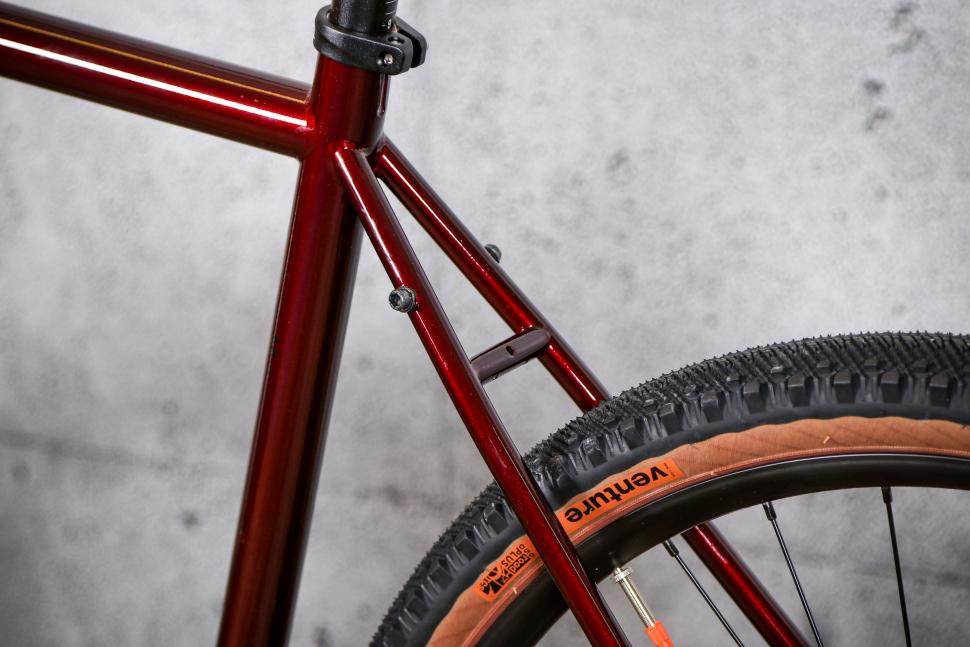




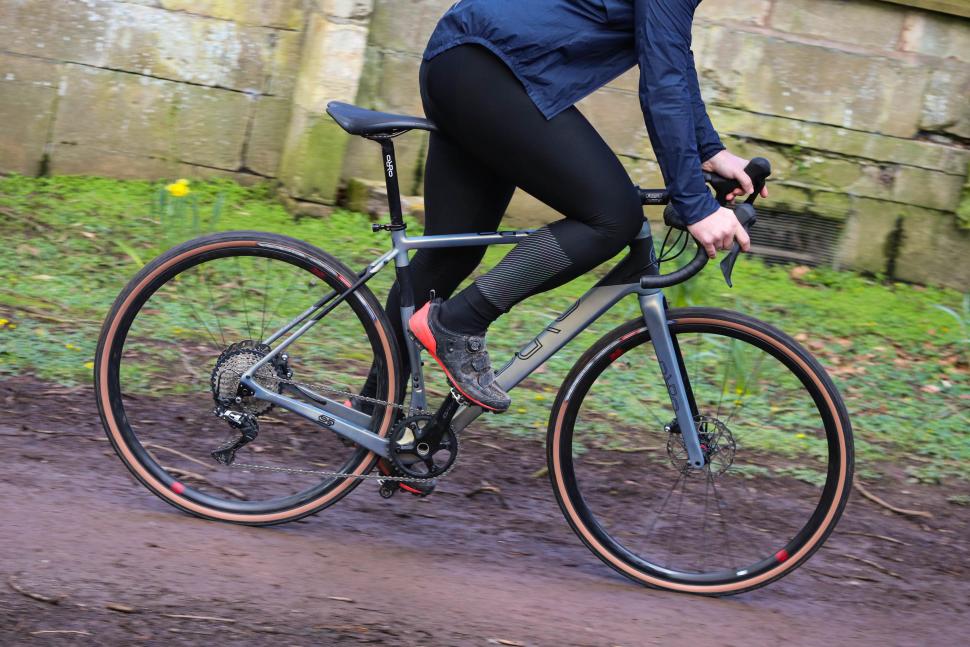
Add new comment
42 comments
My off-the-peg Vitus Substance gravel is the best general bike I have ever had. It came with nondescript steel tubing, Sora 9 speed double 48/32, 32 cassette, TRP Spyre cable discs. It cost £650 at Chain Reaction in November 19 and was verey well prepared. Fantastic, and it's only 5% slower than the Merlin titanium Ultegra 9 speed triple with rim brakes, 25 mm tyres- over a couple of hours. I suppose that percentage would increase over a long day but I don't have the statistics for that yet. The most important features are the wider tyres and the discs.
My old Marin San Rafael with correct tyres would be great gravel bike. More trail than city. Steel, STX crank with lower gearing than later models, 42/32/22, 38c tyres and toe clips, loved it.
This is all just marketing - None of it and would stand up to empirical analysis.
Take these bikes and put their geometries on a spreadsheet, plus the adjustment possibilities, the supposed gravel bike, CX bike, endurance road bike, all-in-one road bike etc. Its all just one huge cloud and totally all over the place.
More than happy with my Cannondale Super X Force 1 ( 1x11 ) for the local canal network ( +60 miles ) and The Severn Way. Just changed to 40mm tubeless knobbly tyres and never looked back.
So basically, gravel bikes are boring, heavy versions of cyclocross bikes or boring heavy versions of touring bikes with bigger tyres.
Why would anyone want one of these, just buy a faster CX or old school tourer.
To put that another way, fast tourers that are more offroad capable, or more forgiving CX bikes which aren't going to break you if you ride them for more than an hour at a time.
It's just a different balance of priorities.
My gravel bike is more aggressive than a conventional tourer, more suited to long rides than a pure CX racer, more capable of handling offroad jaunts than I have the handling skills to take full advantage of and, at ~9kg for a titanium framed bike, it's not exactly a porker. It won't replace my carbon "fast" bike, but for everything else it's a pretty damn good option.
It just boils down to tyre size, a 33mm tyre works to a certain level but most of the time punctures and flats were more likely with the thinner tyres i found when using my old Cannondale Crux.
After just coming back from Kielder i would of found it a lot harder riding 33mm tyres rather than the 40mm ones that my topstone allows for.
No, not really.
Disk? You mean disc brake?
maybe he was thinking of floppy disks at the time..
The 'subtle difference'?
I don't know, what is the difference between cyclocross and £rav€l…?
"you might be surprised that no gravel/adventure bikes have a triple chainset"
Marin Four Corners defo fits the (vaguely defined) category and is a Sora 3x9 triple.
I accept that there's an accepted standard in any bike category, but gravel bike is still so vague. DK200 winning bike this year has front and rear luggage mounting points, but then there's also far more aggressive gravel race bikes, but then there's off road touring bikes. Now the Domane is a gravel bike with 30c tires apparently (which is fine, you can ride loads on that).
I have a gravel bike, which isn't going on gravel until it dries up. I had 2 different gravel bikes a few years back; a cross bike and a modified Boardman hybrid (which was a blast).
TL;DR version - literally anything can be a gravel bike, just ride it on gravel.
I've just put an order in for a new Ridley X Trail Adventure bike to replace my CX bike for the commuting. Like the idea of the adventure bike frame as i have another set of wheels to use for commuting and then at the weekend 650b wheels back on to hit the trails on the local windfarm.
Companies are just bombarding us with choices and the wifes don't like it when you tell them you need another bike to satifsy another niche!
She should be pleased you don’t need another wife for another niche.
I ride a Jamis Renegade but yeah this Gravel bike thing can be a little poorly defined.
A trek 920 is nothing like my Jamis. The 1st gen Diverge didn't have clearances for 'proper' gravel tires. The Light Blue Robinson is a light tourer/ audax bike, but rides nicely off road.
Early gravel raves were a run what you brung thing. Cross bikes, touting bikes, races were won on road bikes.
Gravel bikes now though are, in the main, practical, versatile bikes and I love mine. You don't need to go out and buy one though.
I've just ordered a tripster V2, I will build it up over the next week or so. It seems to have everything I could possibly want from a bike frame. Slack steering, decent stack height for comfy distance riding and huge tyre clearance, and its titanium
Had our Gravel/Adventure bikes made about 10 years ago
Frames are Ti for strength not weight
Had S&S couplings installed for air travel
Did not choose disk brakes; concerned about damage while packing them in hats shell cases
Have ridden them many places across world - great investment
I came at this adventure/gravel bike thing from sort of the opposite direction about 5 years ago.
5 in travel mountain bike frame(Salsa--very light, very good) with a 5 inch travel fork.
Put a full uncut steer tube on and a randonneur bar at road height.
MTB gearing(22-32-44/11-34).
Old Shimano 105 shifter/levers pulling v brakes.
Relatively light wheelset currently running 2.5 inch Schwalbe Moto's.
The whole thing currently sits at 27 lbs.
BUT, my preferred set up is with 1.5 inch inverted tread tires(used to be Avocet Cross II's--hate it that tire is no more; Schwalbes are okay)
With the suspension set properly, the 1.5 tires are fast, cushioned by the suspension, and really dig on loose surfaces.
Finally, if I wanted to spend a bit more $, I could easily get the weight down to the 20 to 22 lb range.
Most of all it rides great!
I can tackle just about any road surface, including about 90% of the pretty technical, steep, singletrack we have here, and enjoy it.
It really shines on dirt/gravel roads; you can sit in and spin the big ring while floating over the bumps.
Cost effective, too
my bike shop banned me from having any more rim brakes after the winter of 2014/5. Harsh maybe, but fair. They pointed out the Diverge range, suggesting that this was the only form of road bike I should be allowed, 'adventure' or 'gravel' never came into it, just extremely tough and ready to go all the places I do - I like to have a choice of road or path.
Match made in heaven - I did a 45 mile spin around the Chilterns first thing this morning, and it takes all the different road surfaces on offer without complaint, and last week I bagged a reasonable contested quarter mile KoM flat segment on it , at 30 mph for 30 seconds - big following wind obviously, and there's lots of people who could go faster if they went that way, but the bike doesn't hang about if you don't want it to.
For me, that's a real winning combination. Not ridden my mtb hard-tail since, and my other bike in use is a Pashley Guv'nor, so I'm covered ....
I would like a "Gravel" geometry bike in titanium with all the eyelets and mounts, so I can make it my one and only road bike. I would have a couple of wheelsets for comfy commuter riding and a set slimmer tyres for club runs/TTs. My Boardman carbon CXR has all these but is a little twitchy(steep head tube angle) when I set it up for club TTs.
One day
Exactly this.
Me too, but with Ti fork, otherwise it is meaningless, the dream of Ti is that it the Highlander of materials being bumproof,rustproof,fatigueproof and at the same time relatively light. The CF forks just destroy this dream.
Planet-X Tempest :
http://www.planetx.co.uk/c/q/bikes/gravel-adventure-bikes/Tempest(link is external)
Just got one, and its brilliant.
2 sets of wheels :
- 28c Pro4 Endurance for winter commuting/Sunday rides/Audax - Mudguards On;
- 40C (!!) WTB nanos - mudguards off for off-road fun !!
https://goo.gl/photos/bxeuD4niaEE342K46
Worth considering the Tempest's Half-sibling, the Alpkit Sonder Camino-Ti: https://www.alpkit.com/sonder/sonder-camino-ti
One of its fathers is Brant Richards (?formerly?) of Planet X/On One fame and you can see the shared DNA.
I'm moving to Scotland from the Fens next year in all likelihood and when I do one of these will likely be high up my shopping list!
Saw a Camino in the flesh, really nice.
Rode one, very nice indeed.
That Tempest looks lovely - how is the mud clearance with 40mm tyres when the Planet X website says max is a 38?
You really have to pay attention in these categories to geometry, the Tempest seems nice but looks like short stack/steep angles CX geometry to me. I have a Carver All-Road build in progress that is taller and slacker like a touring bike, which was what the bikes I prefer used to be called.
.. multi post, sorry
Pages